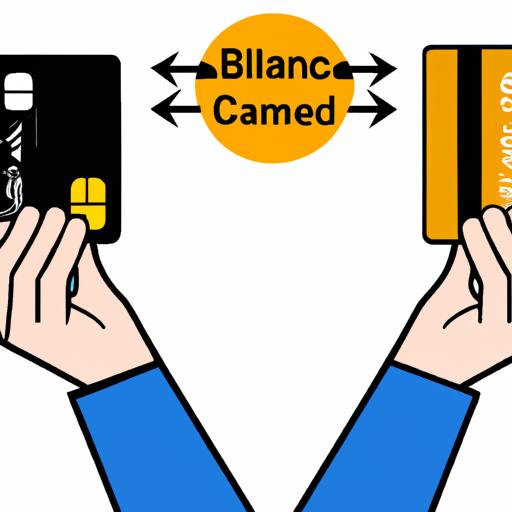Introduction
Definition of Balance Transfer
A balance transfer is a financial maneuver that involves moving existing credit card debt from one card to another, typically with a lower interest rate. This process can help individuals save money on interest payments and pay off their debt more efficiently.
Benefits of Balance Transfer
One of the primary benefits of a balance transfer is the potential to save money on interest charges. By transferring high-interest debt to a card with a lower or 0% introductory rate, individuals can reduce the overall cost of their debt. Additionally, balance transfers can simplify debt repayment by consolidating multiple balances into a single monthly payment, making it easier to track progress and stay on top of payments.
Stay tuned as we delve deeper into the intricacies of balance transfers and provide you with a step-by-step guide on how to successfully execute a balance transfer.
Understanding Balance Transfer
What is a Balance Transfer?
A balance transfer is a financial strategy where you move existing credit card debt from one card to another, usually with a lower interest rate. This can be a smart way to save money on interest and pay off debt more efficiently.
How Does a Balance Transfer Work?
The process of a balance transfer involves transferring the outstanding balance from one credit card to another. This is typically done by applying for a balance transfer credit card with a lower interest rate or a promotional 0% APR period. Once approved, the new card issuer will pay off the debt on your old card, consolidating the balance onto the new card.
Why Do People Consider Balance Transfers?
People often consider balance transfers for various reasons. One common motivation is to save money on interest payments by taking advantage of a lower interest rate offered by the new card. Additionally, consolidating multiple debts into one can simplify monthly payments and make it easier to manage overall debt. Understanding the benefits and mechanics of balance transfers is essential before embarking on this financial strategy.
Eligibility for Balance Transfer
Credit Score Requirements
To qualify for a balance transfer, most credit card issuers typically require a good to excellent credit score. Lenders use your credit score as an indicator of your creditworthiness and ability to repay debt. A higher credit score increases your chances of being approved for a balance transfer card with favorable terms and lower interest rates.
Minimum Transfer Amounts
When considering a balance transfer, it’s essential to be aware of the minimum transfer amounts set by credit card issuers. Some cards may have specific minimum transfer requirements, which could impact your ability to consolidate your debt effectively. Make sure to review these requirements before initiating a balance transfer to ensure smooth processing.
Fees Associated with Balance Transfers
While balance transfers can be a cost-effective way to manage debt, it’s important to be mindful of any associated fees. Credit card issuers may charge a balance transfer fee, typically ranging from 3% to 5% of the transferred amount. Understanding these fees upfront can help you calculate the total cost of the transfer and determine if it aligns with your financial goals.
Steps to Perform a Balance Transfer
Research and Compare Balance Transfer Offers
Before diving into a balance transfer, it is crucial to research and compare various offers from different credit card issuers. Look for cards with low introductory interest rates, minimal fees, and favorable terms. Take your time to analyze the fine print to ensure you understand all the terms and conditions associated with the balance transfer offer.
Apply for a Balance Transfer Credit Card
Once you have identified a suitable balance transfer offer, the next step is to apply for a balance transfer credit card. Fill out the application accurately and provide all required documentation. Keep in mind that credit card issuers may have specific eligibility criteria, such as a minimum credit score, so ensure you meet these requirements before applying.
Transfer Your Balance
After your balance transfer credit card application is approved, it’s time to transfer your existing credit card balance to the new card. This process typically involves providing the account details of your old card to the new issuer. Be mindful of any transfer fees that may apply and make sure to complete the transfer within the specified timeframe to take advantage of the promotional interest rate.
Monitor Your Progress
Once the balance transfer is complete, it’s essential to monitor your progress closely. Keep track of your payments, remaining balance, and the expiration of any promotional rates. Stay disciplined with your payments to avoid incurring additional fees or interest charges. By monitoring your progress, you can effectively manage your debt and work towards becoming debt-free.
Tips for a Successful Balance Transfer
Pay Attention to Promotional Periods and Interest Rates
When considering a balance transfer, it is crucial to pay close attention to the promotional period and interest rates offered by the new credit card. Look for cards with extended 0% APR introductory periods to maximize your savings on interest charges. Understand the terms and conditions of the offer to ensure you are aware of any potential rate increases after the promotional period ends.
Avoid Making New Charges on the Balance Transfer Card
To fully benefit from a balance transfer, it is advisable to avoid making new charges on the card where the transferred balance resides. New purchases may accrue interest at a different rate than the transferred balance, potentially complicating your repayment strategy. Focus on paying down the existing debt before using the card for additional expenses.
Make Timely Payments to Avoid Penalties
Timely payments are essential when executing a balance transfer. Missing a payment can result in penalty fees and potentially negate the benefits of the transfer. Set up automatic payments or reminders to ensure you stay on track with your repayment schedule. By making timely payments, you can maintain a positive credit history and work towards becoming debt-free.
Conclusion
As we conclude this guide on how to do a balance transfer, it is evident that this financial strategy can be a valuable tool for individuals looking to manage and reduce their credit card debt. By taking advantage of lower interest rates and promotional offers, you can save money and simplify your debt repayment process.
Remember to carefully research and compare balance transfer offers, consider your eligibility requirements, and follow the necessary steps to execute a successful balance transfer. By paying attention to details, making timely payments, and avoiding new charges on your balance transfer card, you can make the most of this opportunity to improve your financial situation.
Incorporating balance transfers into your financial plan requires diligence and responsibility, but the potential benefits make it a worthwhile endeavor. Take control of your debt and financial future by utilizing the insights and strategies outlined in this guide. Here’s to a successful balance transfer and a step towards financial freedom!

